The Crazy Production History Behind the Motorcycle Chain
Motorcycle chain lube will make your motorcycle ride better and last longer. Here’s the ultimate guide to taking care of your motorcycle chain.
It can be a messy chore but learning how to clean, lubricate, and maintain your motorcycle chain, will save you future time and money. This is why I want to share my knowledge on how to love your bike with motorcycle chain lube.
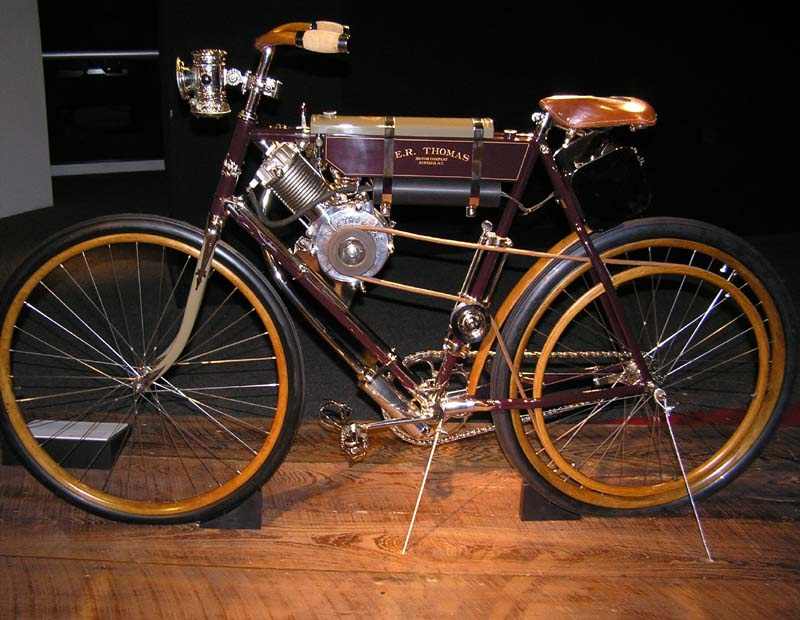
The sole purpose in life for a motorcycle chain is to take power from the engine and deliver it to the back wheel. It does its job incredibly well, and without it, all you have is a very expensive and cumbersome rocking horse.
Back in the days of the dinosaur, final drive for motorized bicycles was a leather belt. This idea was borrowed from the industrial manufacturing equipment of the era and was fine for foot-traffic type speeds.
The moment motorcycles began to get faster the chain became essential equipment. It didn’t slip, stretch or snap like its predecessor, and the leather belt went back to holding up trousers.
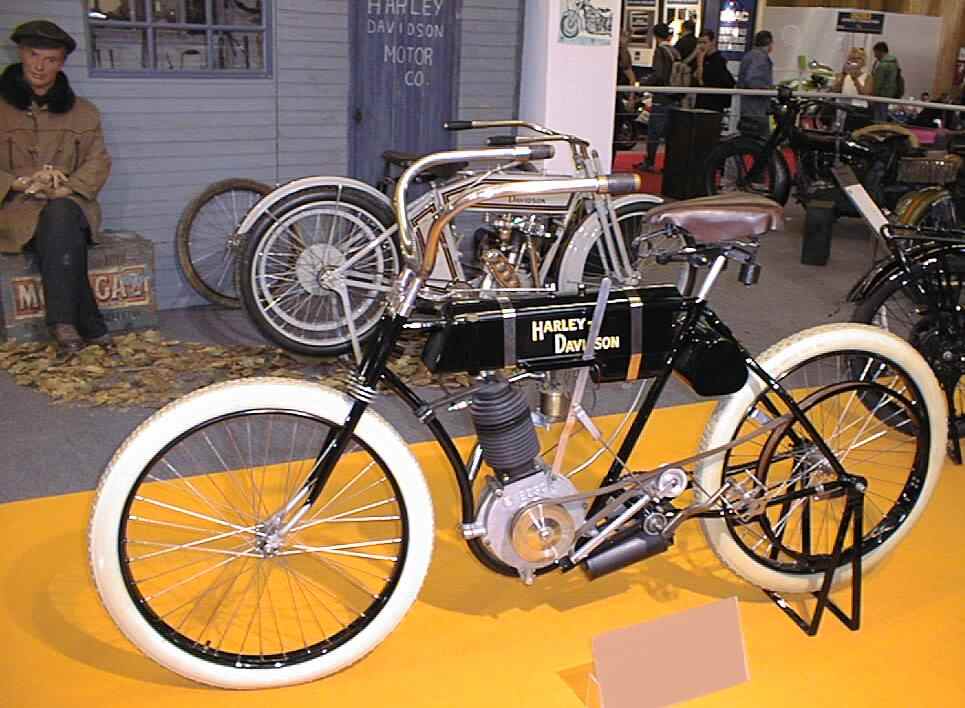
Today, chain drive is the most popular type of final drive system in the world for two reasons. Firstly, under normal circumstances, a chain is pretty much indestructible, and secondly, compared to shaft and Kevlar belt, it’s cheap as chips.
There is another reason too, concerning the amount of power lost in the transfer of energy from the engine to the wheel. A chain transfers around 97% of its payload, making it by far the most efficient type of final drive you can get.
Before you go trading in your BMW though, like everything in life there’s a downside, and that is, chains can be messy as hell and need regular maintenance.
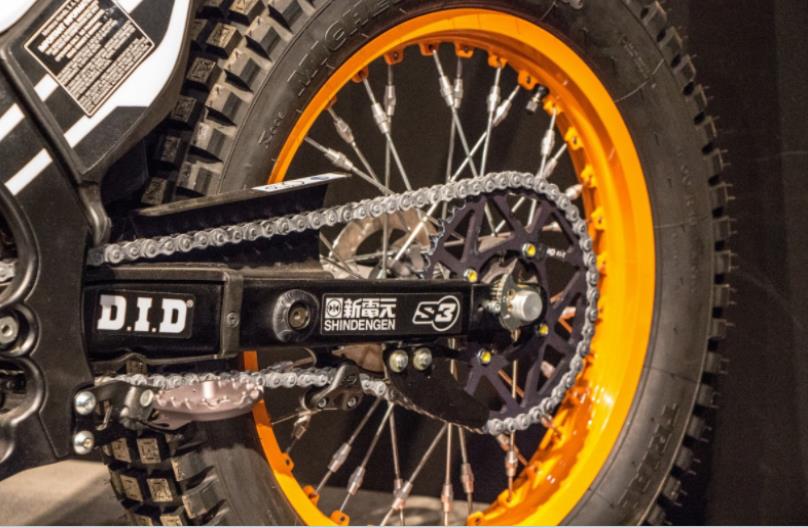
In this article, we’ll be taking a closer look at the humble motorcycle chain and the reasons and methods of keeping it in A1 condition. Here’s a quick breakdown of our running order.
Estimates show that the average Joe is so unenthusiastic about lubing their chain regularly – sadly they get only a third of the mileage of a lubed chain’s capability.
The History and Engineering Behind the Drive Chain
As to who invented the world’s favorite final drive; the jury’s out. Traditionalists say Leonardo da Vinci’s 16th-century sketches clearly show the design for a roller chain.
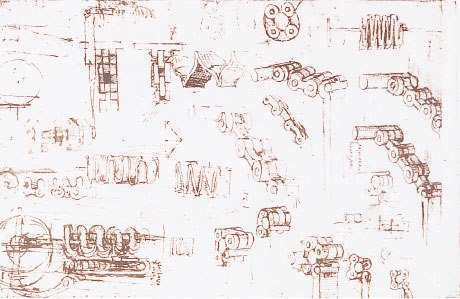
On the other hand, industrialists gave the honor to Hans Renold in 1880. His company is now one of the most well-known chain manufacturers in the world, so I’d say we have a winner.
You’ve got three types of roller chain:
The first is the non-lubricated, everyday bicycle or scooter chain. The design of this chain hasn’t altered for over a century and its uses, include all types of low-power transfer applications.
Second is the O ring chain, as the name suggests, this has a rubber O ring placed in between the inner and outer plates of every link. At the manufacturing stage, grease is vacuum packed inside, the two parts compressed, and the rivets peened over. This process makes the O rings spread, trapping the grease inside.
This type of chain gives vastly superior wear performance over the standard version. The increased tensile strength and high-speed capability make it ideal for motorcycles.
Compared to the common roller chain, it’s light years ahead, but the O ring isn’t infallible. The tiny seals can keep the grease in and perhaps more importantly, keep dirt, grit, and crud out, but they need work to keep them in top-notch condition.

As good as the O ring is, it’s always possible to enhance the design, hence the arrival of the X ring. As with the O ring, this places a rubber seal in between the plates, but yes, you guessed it, it’s X- shaped.
This X- shaped seal dramatically reduces the friction caused by the O ring, by significantly lessening the contact area between the plate and seal. Less friction equates to higher performance, which is why owners of top-shelf sports bikes tend to favor it.
The X-ring is not without its particular problems, as it requires more frequent maintenance and the seals are prone to corrosion from solvents.
Interesting Chain Fact
The Harrier Jump Jet, the world’s only successful vertical takeoff and landing jet fighter, uses motorcycle drive chain. To enable that incredible vertical capability, twin vector thrust nozzles in the front and back of the plane have to work in exact unison. What did they use on the $24m dollar jet to synchronize them? Yup, 50 bucks worth of bike chain. (Source)
Why You Need to Keep it Clean and How
Contrary to popular belief, buying an O or X-ring chain does not exempt you from lubing your chain. Before we even reach that stage though, if you want to get the max from your final drive, you have to clean it regularly.
Due to their location, chains pick up all kinds of nasty crud off the road, and the finer particles can find their way into the moving parts and act like grinding paste.
Now technically, this doesn’t happen so much with an O or X-ring chain, but it’s still a good idea to clean your chain. Forget scratching down your favorite back road, even on your regular commute. Chains get hot, and excess heat is the enemy of moving parts. A serious build-up of road grime (especially in the winter) can hinder heat dissipation and contribute to wear.
When I suggest you ‘regularly clean it’ I don’t mean every other weekend. Adding it to your maintenance regime whenever you do an oil change is about right if you’re on a road bike. If you constantly hit the motocross track or enjoy the longer and dirtier enduro rides your chain maintenance would likely fall into your post ride cleaning routine. Although it sounds like a straightforward job, there are a couple of real big NO-NO’s to observe.
Never do anything relating to your chain with the engine running. Sounds obvious, huh, type ‘fingers caught in motorcycle chain’ into your search engine, then put the ignition key on the workbench!
The second on our ‘Don’t do It’ list concerns the use of cleaning fluid. Using gasoline, acetone or anything similar will degrade your seals, allowing the liquid to get behind them and dissolve the packed in grease.
Either use a specific chain cleaning fluid or kerosene and give the chain a good soaking. There are several useful chain cleaning tools on the market, and these will allow you to keep your fingers clear, scrubbing the chain as you rotate the back wheel by hand. Some high quality motorcycle cleaners can also double as chain cleaner.
Chain Care Quick Guide
Step 1
Get your gear ready. This step includes cleaning fluid, brush or chain cleaning tool, clean rags, and motorcycle chain lube.
Step 2
Get the back wheel off the ground, either by its center stand or using a jack. Do not put the bike on the side stand and lean it over towards you. I’ve seen this done on the dirt and I’ve even helped someone change a tire doing it. It’s not advisable unless you know exactly what you’re doing. Get this maneuver wrong, and you’ll have a few hundred pounds of bike giving you a lap dance. If you are in the process of changing tires, you’re going to need a tire changing tool which can help you.

Step 3
Give the chain a good dousing with cleaning fluid and scrub the bejesus out of it with a brush or chain-cleaning tool. If you’ve got a dirt bike with a non-sealed chain, get the pressure washer on it. Just remember though, to put a bung in the silencer. A pressure washer is not advisable on road bikes, not so much because of the chain, but because the electrics aren’t as robust and waterproofed as that of a dirt bike.
Step 4
Clean the chain by holding a rag around the bottom chain run and slowly rotate the back wheel, so the chain moves away from you.
Step 5
Lube that sucker. If yours is a non-sealed chain, then lube it. If you’re running an O or X, concentrate the lube towards the inner and outer plates of the link. In both cases, don’t overdo it and on your first post-lube ride, check your tire for ‘fling.’
The Great Debate – Wd-40
No chain cleaning article would be complete without dipping into the WD40 debate. Some say it’s the best thing since rear suspension, while others say its devil’s spittle that will rot your O rings.
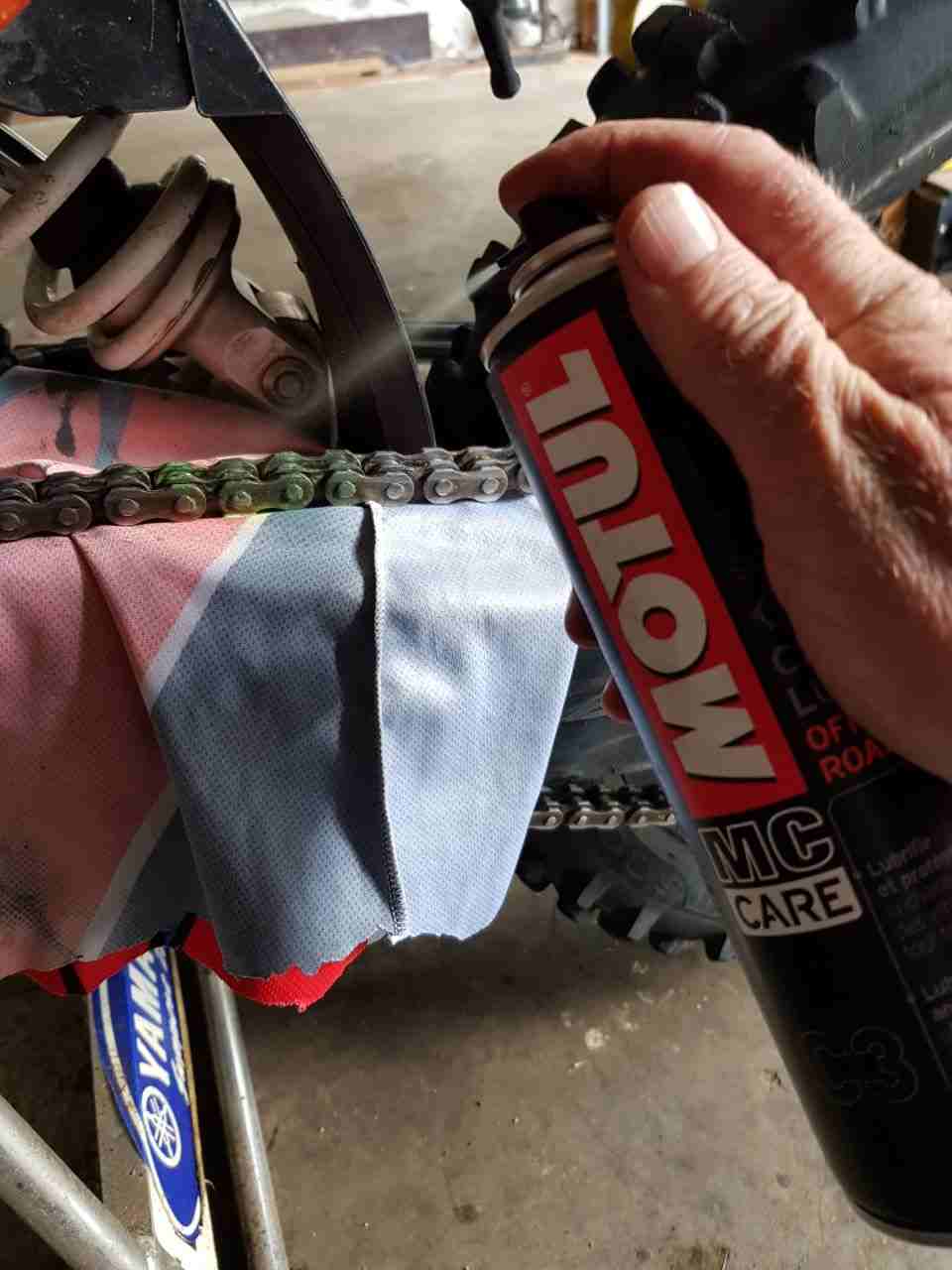
Here’s the bottom line, chain seal manufacturers use a type of rubber called Buna-N. Buna-N is a nitrile rubber, which is resistant to aromatic hydrocarbons, namely oil and grease, etc. Guess what the main constituents of WD40 are? Yup, that’s right, aromatic hydrocarbons. So yes, you can use it to clean your chain, no, it won’t rot your O rings, but my advice is, don’t use it as your only lubricant. This stuff is also great carb cleaner. However, if you still have doubts, you can find the best carb cleaner right here.
Just in case you think I’ve got shares in the company; a gallon of WD40 is around $25, a gallon of kerosene and a squirt bottle comes to about $3.50!
Anyway, back to business, when the chain looks gunge free, dry it off thoroughly by running it slowly through a clean rag. Always hold the cloth around the bottom run of chain and rotate the back wheel slowly clockwise, (for left side chain drive) to avoid pulling your fingers into the sprocket.
If you think this is a bit too much like hard work, consider this. For lubricant to stick correctly, it needs a clean, dry chain. A clean well-lubed chain will last approximately three times longer than its unloved counterpart; it’s as simple as that. So you can see why getting your hands on some motorcycle chain lube is a must. Is this case it’s more about function than looks. The reverse would be true if you’re looking for a chrome cleaner or polish. In case you are – check out our post on the best motorcycle chrome cleaner and polish.
Time for a Check Up
When cleaning your chain, it’s also the best time to check that everything is in working condition. Dirty sprockets hide all manner of horror stories. Ranging from chipped teeth from taking in a stone, hooked teeth from too much right hand, or just badly worn teeth due to a cheap ass aftermarket sprocket.
Make sure you carefully inspect the chain for signs of excessive wear too. Your owner’s manual (or chain manufacturer’s literature) should give you specific instructions on what to look for wear and tear wise.
This procedure usually involves, measuring a set number of links and if the measurement exceeds the recommended length, then the chain has stretched and should be replaced.
Don’t panic if you haven’t got either of the above, as with everything to do with your bike, there’s an old-school way to do everything. So, go to the back of your bike, and grab hold of the chain at approximately three o’clock. That’s the position on the sprocket by the way, not halfway through the afternoon!
Try pulling the chain away from the sprocket, if it moves enough to expose approximately half a tooth, then its time to wave goodbye. There is another method which involves removing the chain altogether and holding it with the rivets/rollers facing up and seeing how much the chain curves, but maybe this one’s a bit too old-school.
Take note; if you ignore a severely slack or worn chain, you are risking it jumping a cog or worse case scenario, jumping the sprocket altogether. The former will chew up the teeth while the latter will lock your back wheel, causing all manner of mayhem.
Why You Need to Lube Your Chain
Once again, this may seem like a no-brainer, but the whole point of this article is to give you the reasons behind the everyday things we take for granted. By doing this, we get out of the ‘I can’t be bothered,’ mentality because it’s important to understand the point of the task.
The basic roller chain has five components:
The outer plate (1), the inner plate (2), Pin (3), Bushing (4) and Roller (5)
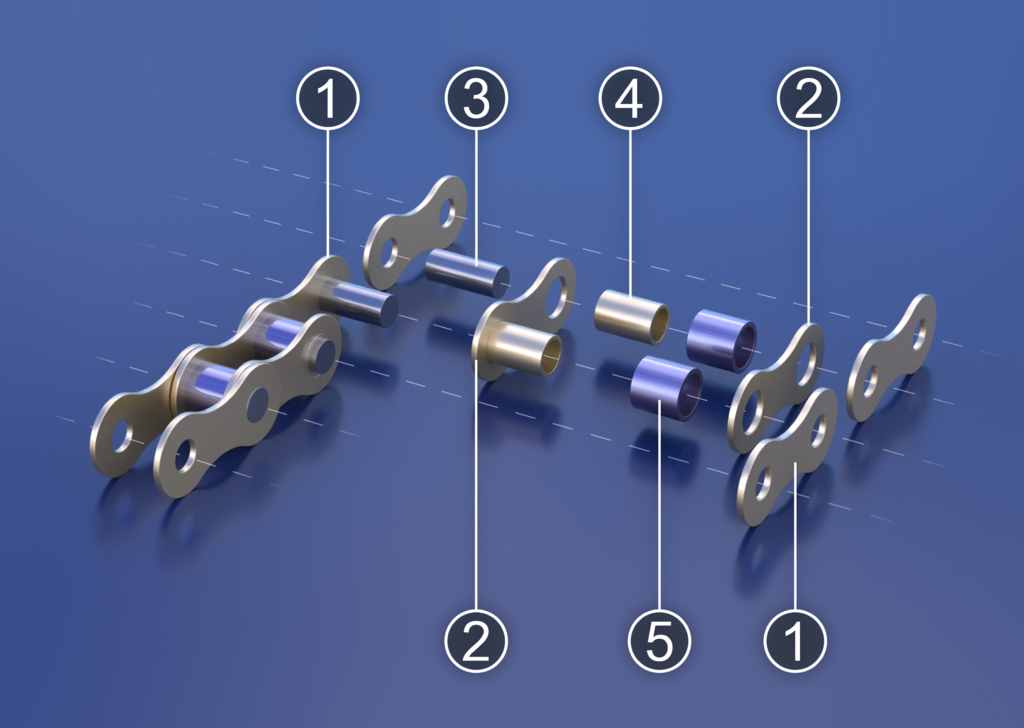
As is typical with moving metal parts, friction causes heat and heat results in expansion. So if friction is the enemy, then lubrication is our best friend.
If you think spraying grease through a tiny tube is messy work, then spare a thought for your biking predecessors. The best way to lube your chain in the bad old days involved removing it from the bike, heating up a tin of solid grease until liquid, and immersing the chain. It was dangerous, smelly and very messy.
Whether you spray it or boil it though, the result is the same. Lubricant creates a protective barrier that helps prolong the shelf life of your chain considerably in several different ways.
Firstly, it reduces friction between the moving parts; this lessens wear, which in turn lowers operating temperatures. It also prevents surface corrosion and lastly, helps keep out contaminants. By contaminant, we mean the 101 different kinds of crud kicked up from the road that tries to get in-between the moving parts.
So from all of the above, you can see just how vital that tin of squirty goo really is. Now I know what you’re going to say, ‘if I go to the expense of buying an O or X-ring chain which has the grease already sealed in, I can forget lubing, right?’
That’s a good question, and many bikers think they don’t need to, but they’d be wrong. The seal, be it O, X or any other letter of the alphabet, only seals grease into the pins. That still leaves the inner and outer plates, plus the rollers that need lubricating.
How to Lubricate Your Chain
Get your back wheel in the air, just high enough to spin the wheel. If you can’t, you’ll just have to move your bike forward a foot at a time.
We’ve already looked at the ins and outs of cleaning your chain – so having done that the best way to lube it is after a run around the block. Once again, this isn’t cast in stone, but a warm chain lets the lube really get into the nooks and crannies.
Rotating the wheel slowly by hand counterclockwise (remember the trapped finger thing!) spray the motorcycle chain lube onto the lower chain run. Moving the wheel c/clockwise means the lubed part of the chain wraps around the sprocket helping push it right in.
Auto Chain Lubing Devices
These are ingenious devices that attach to the back end of your bike and take care of all your lubing requirements, by drip-feeding oil directly on to the chain as you ride.
A quick search of the web will rapidly establish just how effective auto chain lubes are, apparently extending the life of your chain dramatically. Just bear in mind that the evidence for this mostly comes from auto lube device manufacturers, so as with everything in life, read up then make up your own mind.
That Covers it
And that, fellow bikers, is that. We’ve covered the reasons behind cleaning and lubricating your chain and the methods of carrying it out. None of it is rocket science, but you do need to take care, be methodical and get all your kit ready before you begin. Yeah ok, it can be a bit messy but embrace the suck, don’t forget, a correctly lubed chain is a happy chain, so enjoy.
As with all our articles, if we’ve missed anything out, you want to tell us we’re great, or even give us a verbal slappin’ or if you’ve found another type of motorcycle chain lube you think we should test, the comment section awaits.
